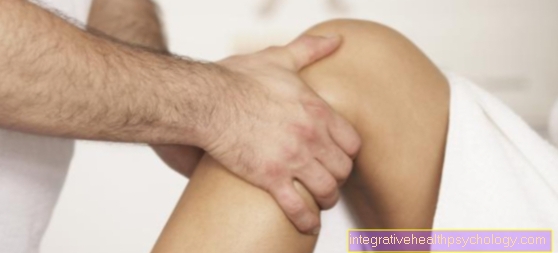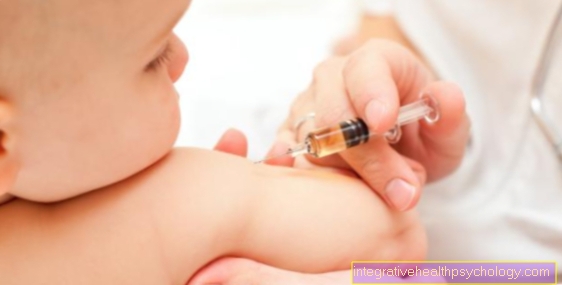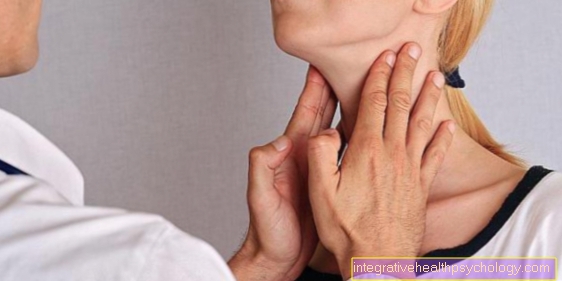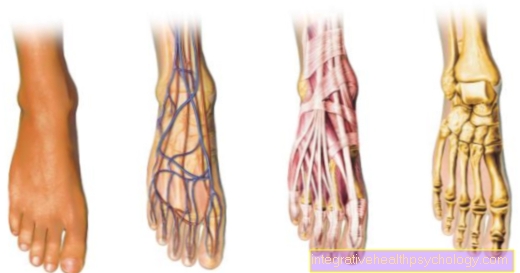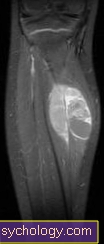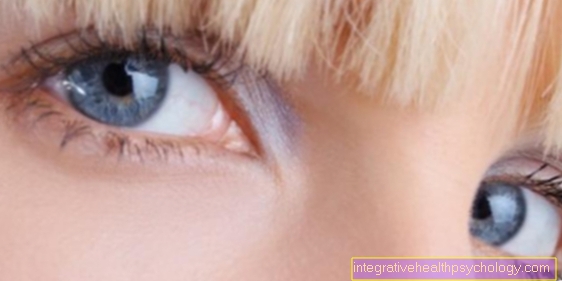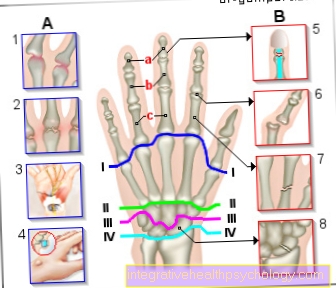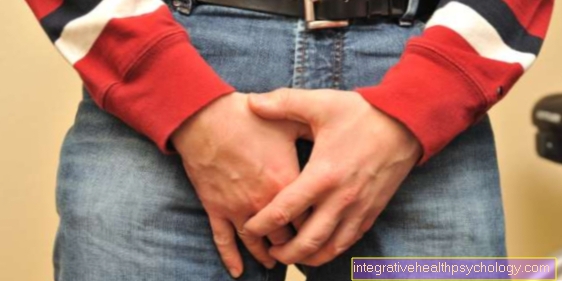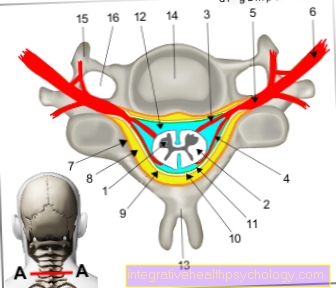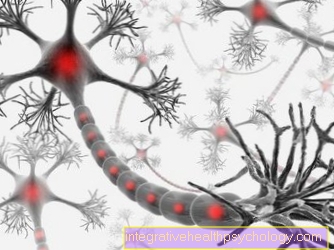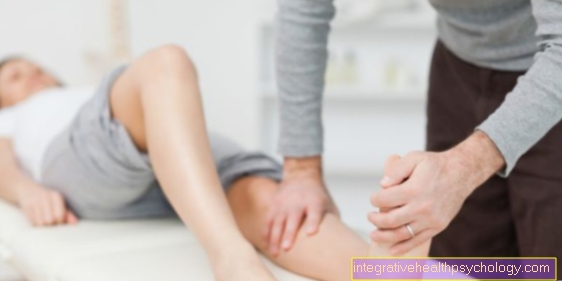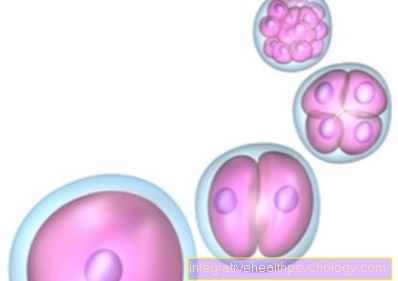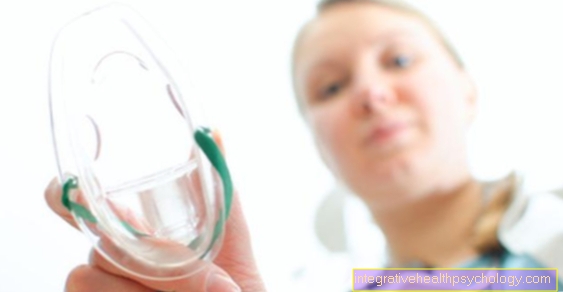Treatment of phlebitis
introduction
Phlebitis is characterized by a painful overheating and pain. Phlebitis often resolves within a few days with only a few remedies, but a visit to the doctor and treatment is very important. Because there is a risk that the phlebitis spreads to deeper veins. This can lead to life-threatening thromboses (vein occlusion) and pulmonary embolism (vein occlusion in the lungs). Phlebitis is usually treated locally with ointments, so that no medication has to be taken.

How can phlebitis be treated?
Phlebitis is treated primarily with anti-inflammatory, topical and cooling ointments. Local therapy for superficial phlebitis is sufficient if there is no evidence that the inflammation has spread to the deep veins.
If you suspect a phlebitis, you should definitely consult a family doctor. The doctor can assess the phlebitis, prescribe ointments and weigh up the risk of possible complications and, if necessary, initiate further treatment steps.
Movement is very important for the functionality of the veins. This gets the circulation going and increases the blood flow in the veins. This supports the healing process. Normal walking is sufficient for this, insofar as this is possible due to pain and swelling. Before starting any sporting activity, a doctor should rule out a thrombosis. Standing around, however, should be avoided.
In some cases, surgery is required. Small incisions can be used to remove blood clots. It is also advisable to remove the entire vein from time to time, e.g. if this is severely affected or if there are also strong varicose veins.
There is also the option of taking a cure for severe or recurring phlebitis. The spa houses offer intensive and extensive treatment and advice.
In general, smoking also has a negative impact on vein health. Because smoking promotes the occurrence of phlebitis. Women who also use hormonal contraception are particularly at risk.
Read more on the topic: Phlebitis
Also learn about the Duration of a phlebitis
Home remedies
Classic home remedies that are used are different wraps. Quark wraps, for example, should be effective. Quark wraps have a cooling and anti-inflammatory effect. For the quark wraps, the quark should not be used straight from the refrigerator. In addition, it should not be applied directly to the inflamed skin. Gauze bandages are suitable for demarcation. Wraps with vinegar water, alcohol or clay are also used.
In addition to the various compresses, lots of exercise and vein walking are helpful. In vein walking, the muscle pump should be activated in a targeted manner. For this, special attention is paid to the rolling and pushing movements of the foot when walking. Even if the home remedies mentioned are very helpful for a phlebitis, a doctor should still be consulted for an exact clarification.
Cool
The cooling has a decongestant and pain-relieving effect. Cooling can be achieved with ice cubes or cold packs. In addition, different envelopes such as Quark wraps are cooling and are often used.
Elevate
Raising the legs supports the work of the veins like compression stockings - the return of blood to the heart. In addition, lying up has a pain-relieving effect. In addition to putting your feet up, you should also ensure sufficient movement, as this activates the muscle pump in the legs, which supports the vein work.
Compression stockings
Compression stockings help the leg veins to carry blood back to the heart. This is important for maintaining blood flow. This can also counteract the spread of the inflammation into the deeper veins. Wearing compression stockings is not always necessary, but is generally recommended. However, due to pain, it is not always possible to wear compression stockings at the beginning of therapy. In the case of weak veins or varicose veins, the wearing of compression stockings is highly recommended, even if many find this rather uncomfortable. Compression stockings are available in medical supply stores.
Also read the article: Phlebitis in the leg.
Medication
In addition to using ointments, in most cases it is not necessary to take any medication. However, if the pain is severe, pain medication can be taken. Non-steroidal anti-inflammatory drugs such as diclofenac or ibuprofen are recommended here. Often, however, topical application as an ointment is sufficient.
Various phytopharmaceuticals (medicinal products of plant origin) are available on the market to support vein health. Their effect, which has not (yet) been scientifically proven, is more likely to be seen with long-term use. So they can be supportive during the inflammation and continue to be taken preventively after healing. Among the phytopharmaceuticals, horse chestnut, butcher's broom or red vine leaves are recommended for phlebitis. They are supposed to seal the blood vessels and prevent fluid build-up in the tissue.
In severe cases of phlebitis, blood-thinning medication must be taken as there is a risk of thrombosis. When a thrombosis occurs, a blood clot forms in the veins. In this case, it is common to give heparin for thrombosis prophylaxis.
Anoint
Phlebitis is treated primarily with ointments. They are anti-inflammatory and decongestant ointments.
A heparin ointment is often used in treatment. It contains the anticoagulant heparin. It has a cooling and decongestant effect. The ointment should be applied two to three times a day. However, the treatment should not last longer than ten days.
In addition, ointments with the active ingredient proteoglycan chondroitin polysulfate are used. This active ingredient penetrates the skin and has a cooling and anti-inflammatory effect. The ointment is also applied two to three times a day and then massaged in. The application takes place for one to two weeks.
There are also ointments from naturopathy. These can e.g. Contains horse chestnut as an active ingredient. The ointment is used one to three times a day for four weeks.
Antibiotics
An antibiotic is only used to treat if the phlebitis is caused by bacteria or is made worse by bacteria. Bacteria are not necessarily involved in phlebitis. One clue that bacteria play a role in inflammation is the appearance of a fever. In the case of bacterial involvement, a suitable antibiotic is given depending on the bacterium. This should then be used according to the doctor's instructions.
Rivanol
Rivanol acts as a germicidal antiseptic. It is applied to the skin in poultices and reduces the number of bacteria there. In addition to many other diseases, it is also used in therapy for phlebitis. Rivanol is used twice a day. However, it should not be used for longer than a period of seven days. Unfortunately, the rivanol turns the skin dry and yellow. If you are pregnant or breastfeeding, you should refrain from using Rivanol.
zinc
The mineral zinc is said to have a strengthening effect on the vein walls and support healing processes. In addition, zinc is said to have an anti-inflammatory effect. Foods that are high in zinc include oysters, liver, legumes, meat, cheese, and whole grains. It should be noted that the body can absorb zinc better from animal products than from vegetable products. Although zinc ointments have an anti-inflammatory effect and are often used, they still play no role in the treatment of phlebitis.
Cortisone
Cortisone can also be produced by the body itself. It has an anti-inflammatory effect. However, it has not yet been extensively investigated in its use against phlebitis, so that there is (yet) no proof of its effectiveness.
buckeye
Horse chestnut is an active ingredient from naturopathy. Horse chestnut extracts are said to have an overall positive effect on the veins. They increase the elasticity of the veins and improve the sealing of the vein walls. The horse chestnut has a decongestant effect by promoting the regression of water retention and thereby reducing complaints such as feelings of heaviness and tension. In addition, it should have a mild antispasmodic and anti-inflammatory effect. It can be used not only for phlebitis, but also for numerous other diseases of the veins, such as with varicose veins.
Also read the article: Home remedies for phlebitis.
homeopathy
In addition to general medical applications, there are also homeopathic approaches for treating phlebitis. A homeopathic remedy that is recommended is arnica, which should be taken for several weeks. But witch hazel can also be taken. When choosing the right substance, the accompanying symptoms also play an important role.
- Apis: If there is ankle edema or swelling
- Echinacea: basic treatment
- Mercurius Solub H: For burning, stabbing pain and sensitivity to touch
- Lachesis and / or Belladonna: In the case of very acute inflammation (in this case, these can also be taken every hour and discontinued as soon as they improve)
- Pulsatilla: For existing tension pains due to blocked veins
For the treatment of phlebitis, especially in the more difficult course, it can be assumed that homeopathic measures alone are not sufficient. Their effect is generally rated as minor.
Schuessler salts
There is no scientific proof of the effectiveness of Schuessler salts. In the case of phlebitis, Schüßler Salt No. 3 (Ferrrum phosphoricum) D12 is recommended. If there is also pain, the Schüßler Salt No. 1 (Calcium fluoratum) D12 should have a soothing effect alternating with Schüßler Salt No. 4 (Kalium chloratum) D6. In addition, if you have varicose veins, you can also take Schüßler Salt No. 1 (Calcium fluoratum) D12 alternating with Schüßler Salt No. 11 (Silicea) D12. For the prophylaxis of a thrombosis, Schüßler salt No. 4 (potassium chloratum) 6X alternating with Schüßler salt No. 7 (magnesium phosphoricum) 6X should be helpful.
Read more about this at: Schuessler salts
Which doctor treats phlebitis?
The first point of contact in the event of phlebitis is your family doctor. As a rule, the family doctor can treat the phlebitis.
In complicated or lengthy cases, he will refer you to a specialist. A vascular surgeon will remove the varicose veins, which is often associated with phlebitis. There are also specialized spa houses in Germany where specific and extensive treatment takes place.

